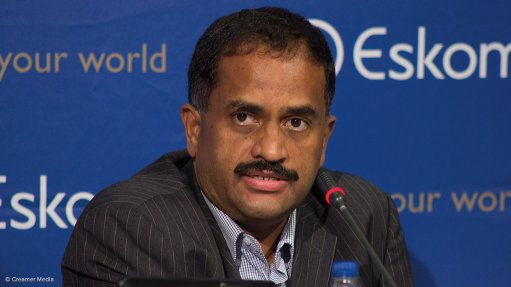
Eskom group executive for transmission Thava Govender
Photo by: Duane Daws
South Africa’s State-owned electricity utility Eskom has called for the creation of an integrated African power pool to facilitate greater electricity trade across borders and to encourage new investments in generation plants.
Speaking at the Africa Energy Indaba on Wednesday, group executive for transmission Thava Govender said the continent required greater interconnectivity, as well as efficient transmission infrastructure to facilitate cross-border sales to areas of demand.
“To become more flexible in optimising the [energy] resources of individual countries we need to develop an integrated African power pool.
“While we have established power pools on the continent – and Eskom is a member of the Southern African Power Pool (SAPP) – the interconnectivity of the system needs to be increased to ensure that the resilience of the power system is improved.”
Such interconnectivity, which emerged as a key theme of the 2016 indaba, would enable “wheeling to areas and countries that may have energy constraints, such as those caused by droughts and plant unavailability”.
Govender made specific reference to the current drought-induced power constraints being experienced in Zambia and Zimbabwe, which had arisen primarily as a result of falling Kariba dam water levels. The dam’s level stood at around 12% currently, from over 68% a year-and-a-half ago, which had severely limited the dam’s hydroelectricity output.
Eskom, he said, was supplying electricity to Zambia and Zimbabwe during off-peak periods, as well as at times in the day when the utility had sufficient capacity to do so.
He indicated that Eskom was also keen to grow its own hydroelectric imports, beyond that being received from Cahora Bassa, in Mozambique. Eskom was optimistic that the Cahora Bassa North Bank project could, in future, add up to 500 MW of additional capacity.
World Energy Council secretary-general Dr Christoph Frei added that, while the potential for microgrids was growing, the transmission “backbone” remained fundamental to improving energy resilience.
Such interconnectivity, Frei added, would be critical to ensuring the actualisation of Southern Africa’s impressive hydroelectric potential.
He was particularly keen to support the acceleration of the ‘Zizabona’ electricity transmission interconnector, which could facilitate power trade across Zimbabwe, Zambia, Botswana and Namibia, ease congestion on the existing north-south transmission corridor from South Africa to Zimbabwe and add a 400 kV western corridor to the SAPP.
It was not the only important interconnector for the region, with the development of the Grand Inga project also hinging on the development of transmission infrastructure. However, Frei argued that it was important for regional actors to begin committing to flagship-type cross-border projects.